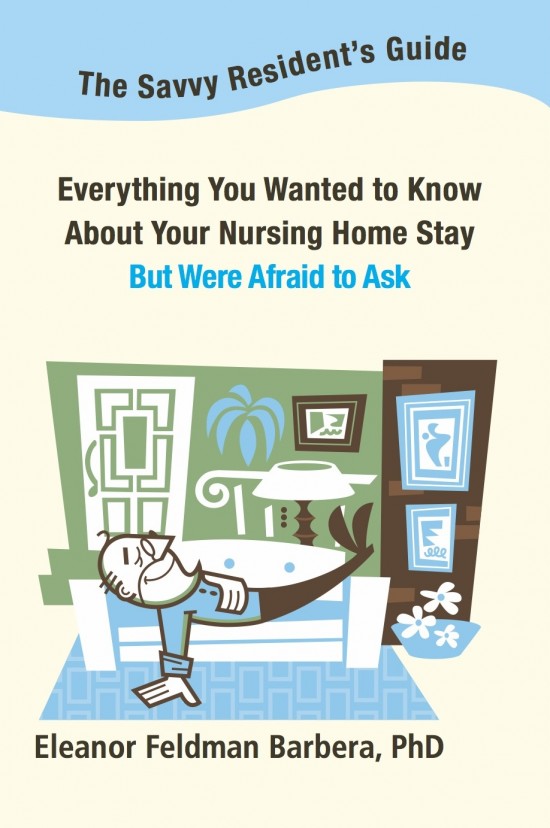Category: Books/media of note
Posted by Dr. El - March 30, 2020 - Books/media of note

Thank you to Bruce Horovitz and AARP for tackling this painful aspect of resident care during Covid-19 and for mentioning my work.
Coronavirus restrictions to protect our most vulnerable alter end-of-life rituals
After 45 years of marriage, the cruel twists of fate now leave Jean Ross and her seriously ailing husband, Phil, sadly hoping for a best-case scenario, under which they would be able to see each other without waiting for weeks, months or even longer.
It would be the best case because it could potentially be deadly if Phil, 69, were to catch the coronavirus in his current condition.
Phil is convalescing at a rehab facility in Alexandria, Virginia, following a series of six surgeries to amputate his right arm and right leg, necessitated by a serious allergic reaction to medications after an illness around Christmas. Jean has been barred from visiting him since the facility began following the Centers for Medicare & Medicaid Services’ (CMS) tough new coronavirus-related restrictions on visitors to nursing homes, hospitals and convalescent facilities.
“He’s weak as a kitten due to three months in bed and very little rehab,” says Jean, who also turns 70 this year and had been completing plans with Phil to retire and move from Vienna, Virginia, to live closer to their daughter in suburban Philadelphia, before he became ill. “I’m looking at a new reality. It was wrenching last night to say on the phone, ‘I don’t know when I’ll see you again.’ “
For the entire article, visit:
Coronavirus restrictions to protect our most vulnerable alter end-of-life rituals

Posted by Dr. El - June 12, 2019 - Books/media of note

Thank you to author Deborah Quilter and Next Avenue for an even-handed article about nursing homes and for mentioning my work. NextAvenue is “public media’s first and only national journalism service for America’s booming older population. [Their] daily content delivers vital ideas, context and perspectives on issues that matter most as we age.”
Keeping great caregivers is one of the biggest challenges the facilities face
Massaging elderly residents’ hands is one of the favorite parts of Kathy Hehl Curran’s job at Filosa’s Hancock Hall, a nursing home in Danbury, Conn. The registered nurse says it makes her charges feel relaxed, and sometimes they’ll confide their worries.
“It’s a way to make them feel good and to validate their concerns,” Curran says. “If something comes up that needs to be taken care of, then I need to go to the right person and make that happen.”
Curran has been at her job for 36 years. This speaks volumes about not only her devotion to her work but also Hancock Hall’s winning formula for retaining caregiving staff. Curran credits this to the facility being owned and operated by a family rather than a corporation.
“If you’re not taking care of your caregivers, how are they going to deliver good care for your clients?”
When Curran wanted to go back to school, her employers made it possible for her to do that and keep her position. She could move to several different jobs within the company, rather than leave her job to gain other experience. Curran also likes the teamwork and supportive administration at her workplace.
Curran’s experience highlights many reasons why caregivers stay: devotion to the population, having their needs met by administration and the autonomy to correct problems that arise.
For the entire article, visit:

Posted by Dr. El - July 29, 2018 - Books/media of note, Personal Reflections, Role of psychologists, Talks/Radio shows

NursingAssistantGuides.com, an educational site for certified nursing assistants, has a new podcast series featuring experts in the field of geriatrics and long-term care. The podcasts offer the chance for those considering or working toward becoming a nursing assistant to get insider information about the field. I was pleased to be interviewed by registered nurse Patricia Laramee about mental health and elder care for their most recent podcast.
To listen, click HERE and be sure to check out the other excellent podcasts on this page.

Patricia Laramee, RN of NursingAssistantGuides.com
Posted by Dr. El - March 19, 2018 - Books/media of note, Business Strategies, McKnight's Long-Term Care News

Here’s my latest article on McKnight’s Long-Term Care News:

Three new books on aging and healthcare recently crossed my desk, each with completely different takes on our industry.
One focuses on ways in which companies, including long-term care organizations, can save on healthcare costs. In another, the author’s insights into elder wisdom can be used by facilities to add to the quality of life of residents. The final book offers an outsider’s view into how our field is perceived by older adults and their families.
Cost savings
In “Health-Wealth: 9 Steps to Financial Recovery,” author Josh Luke, Ph.D., a former hospital CEO turned “healthcare futurist,” argues that our healthcare delivery system is so badly broken that we should seek a new model for the healthcare needs of employees.
He outlines a method to implement a consumer-driven model that improves pricing transparency and control over costs. Some of the suggestions are likely to both reduce expenses and increase employee satisfaction. For example, an organization-wide emphasis on health and wellness can be a popular program with medical savings.
Other ideas, such as charging the employee a percentage of care costs over their maximum deductible, won’t be universally appealing but could influence workers to choose more affordable “centers of value” during a health crisis.
If organizations find creative ways to reduce healthcare expenditures for their employees, the market is bound to shift in unexpected directions — and that’s exactly what “industry disruptor” Josh Luke is hoping for.
Quality of life
The second book, “The End of Old Age” by Marc Agronin, M.D., offers a hopeful view of aging that will resonate with those in the field.
I was particularly struck by the fact that Agronin, a geriatric psychiatrist, began his book with a chapter on why we should grow old, addressing issues around end of life choices and the way we approach old age. The foundation of acknowledging that some people don’t actually want to live to old age is a crucial exploration that sets the tone for the rest of the book.
Subsequent chapters point to the value of aging in very specific ways. While older adults may not surpass younger people at tasks that require speed or visual acuity, for example, Agronin details five different forms of wisdom in which elders excel. The book includes tools so that others, such as families and staff members, can use his model to help elders make use of their strengths and recognize their purpose at this phase of life.
For the entire article, visit:



Posted by Dr. El - March 9, 2018 - Books/media of note, Business Strategies, McKnight's Long-Term Care News

McKnight’s Online Expo, FREE, March 14th and 15th 2018
Earn 5 Free CEUs at 5 Free webinars

Once again, McKnight’s will host its annual online expo, which is a chance to attend a conference without leaving your desk. Register for the conference in advance, and then log in to hear the talks, visit the vendors, and chat with the reps and attendees.
This year’s topics are:
PAYMENT: Operational strategies for surviving regulatory, payment and database changes
WOUND CARE: Is the Braden Scale increasing your facility’s risk of malpractice?
TECHNOLOGY: Telehealth and Reimbursement: What you need to know for the near term
QUALITY: Beyond a fire drill: Emergency prep steps for active shooters in your building
CAPITAL: The new funding sources
Posted by Dr. El - August 4, 2017 - Books/media of note, McKnight's Long-Term Care News, Personal Reflections

Here’s my latest article on McKnight’s Long-Term Care News:

I was perusing The New York Times last week when I came upon an article about a play centering on my favorite topic — aging.
“Singing Beach,” by playwright Tina Howe, revolves around the drama that consumes a family when confronted with the need to place an elderly parent in a nursing home. Howe is 79 years old and lives with her 81-year old husband, who has been diagnosed with Alzheimer’s disease. She says the play was inspired by the care needs of her father years ago.
I enlisted a friend with similar interests to accompany me to the performance. “The director is a friend of mine,” I told her. “And I’m curious to see how long-term care is portrayed in the show.”
Howe, an Obie Award winner and two-time Pulitzer Prize finalist, notes that all the producers she’d initially approached turned down the script. Then, she encountered my director friend, Ari Laura Kreith, who found the subject in keeping with the mission of her company Theatre 167.
According to its website, Theatre 167 was “born in a community where 167 different languages are spoken” and it “creates, cultivates, and supports new work by artists of wide-ranging backgrounds, traditions, and beliefs” in order to provide “theatrical events that deepen and enhance our understanding of one another.”
Given our youth-obsessed culture and the paucity of “coming of old age” films and other media, this play certainly contributes a unique perspective and one that is, at the same time, universal. After all, among the 167 languages mentioned, each has speakers who are older adults and may one day be in need of long-term care.
For the entire article, visit:

Graphic image by Kelly Pooler, collage with Katsushika Hokusai’s The Great Wave
Posted by Dr. El - December 7, 2016 - Books/media of note, Bullying/Senior bullying, Business Strategies, Common Nursing Home Problems and How Psychologists Can Solve Them, Customer service, Dementia, Engaging with families, McKnight's Long-Term Care News

The Savvy Resident’s Guide can help set reasonable expectations for your new residents and families, leading them to view their stays in a more favorable light. To see how, download a FREE Kindle version between December 7-9th and take advantage of Holidays Savings of 20% off bulk orders of 25 or more copies through Friday, December 23rd. Use the code MCKNIGHTS at checkout.
It’s like giving people 24/7 access to an experienced nursing home shrink who tells it like it is with gentle humor and answers every question before it’s asked. Put a copy in every rehab room and watch your customer satisfaction reviews improve!
For more great resources, read my latest article on McKnight’s Long-Term Care News:

Over the past year, I’ve been involved with several exciting long-term care-related projects that I can now tell you about. In the spirit of the season, I wanted to spread some good cheer with them*, and also offer a gift.
The first is a book entitled “Bullying Among Older Adults: How to Recognize and Address an Unseen Epidemic” by Robin P. Bonifas, to which I had the honor of contributing a chapter. This volume addresses the effects of bullying among seniors and outlines actions which facilities and communities can take to address the problem. It provides step-by-step assessment strategies and anti-bullying interventions that will increase staff awareness and improve day-to-day interactions.
In another publication, fellow geropsychologists Kelly O’Shea Carney and Margaret P. Norris have put their years of experience to paper in “Transforming Long-Term Care: Expanded Roles for Mental Health Professionals.” As I state in my review of their work, “The book will … appeal to long-term care policy strategists and facility managers looking for ways to reduce costs while improving care quality and staff turnover.” The book digs deeper into the Eldercare Method (which I earlier discussed here) and outlines ways in which long-term care can make better use of its consulting psychologists.
.
.
.
And finally, I’d like to offer the opportunity to download — through this Friday — a free Kindle version of my book, “The Savvy Resident’s Guide: Everything You Wanted to Know About Your Nursing Home Stay But Were Afraid to Ask.” This large-print guidebook provides essential facility-friendly information in an entertaining format for residents and family members regarding how to make the most of their time in a nursing home. (If you like it as much as I think you will, order here by Dec. 23 for a 20% discount for purchases of 25 or more. Use the code MCKNIGHTS upon checkout.)
*Full disclosure: I do not benefit financially from mentioning the resources of my colleagues or from any purchases of their products.
For the entire article, visit:

Posted by Dr. El - September 28, 2016 - Books/media of note, Business Strategies, McKnight's Long-Term Care News, Motivating staff

Here’s my latest article on McKnight’s Long-Term Care News:

Once, when I worked for a managed care company, I rode down a packed elevator with the CEO, who commented drily on the crowd, saying, “It must be 5:01.”
What I thought, but did not say, was that there were reasons his staff members weren’t staying more than a minute past the hour. It was a reflection of a disengaged workforce without connections to the job or each other that might extend to a post-work conversation. (It should come as no surprise that I left my position shortly after this elevator ride.)
To stem the tide of departures, it’s important to find out why certified nursing aides are flying out the door either for the evening or for good. Here are some methods for getting the inside scoop:
1. Ask them — It might sound obvious, but it isn’t often done. The National Nursing Assistant Survey (NNAS), conducted in 2004, is an eye-opening view into the lives and challenges of working as an aide on a national level. Adapting the NNAS questions for use in a particular facility — or using an assessment company to measure employee satisfaction — can help determine, among other things, whether the initial training programs you offer meet the needs of your staff or if transportation problems are interfering with their ability to report to work. Such information could lead to relatively easy fixes that reduce turnover.
2. Join them — I spoke with Sarah Poat Stewart, LNHA, CNA, an administrator who trained as an aide and recently worked the 3-11 shift. Stewart, who is based at Signature HealthCARE’s Oakview Nursing & Rehabilitation Center in Kentucky, finds her participation as an aide reduces the barriers between management and employees and leads to more respect on both sides. In a video about Signature’s goal to have all staff trained as CNAs, managers who worked on the floor had a better understanding of the jobs done by aides and the tools they need to do so.
3. Read the minds of those who stay — If you can’t roll up your sleeves and help a resident into a Hoyer lift yourself, reading CNA Edge is the next best thing.
For the entire article, visit:
Posted by Dr. El - July 14, 2016 - Books/media of note, Business Strategies, Customer service, Resident education/Support groups, Something Good About Nursing Homes

Food for thought in this New York Times article:
By WINNIE HU
JULY 12, 2016
When Audrey Davison met someone special at her nursing home, she wanted to love her man.
Her nurses and aides at the Hebrew Home at Riverdale did not try to stop her. On the contrary, she was allowed to stay over in her boyfriend’s room with the door shut under the Bronx home’s stated “sexual expression policy.” One aide even made the couple a “Do Not Disturb” sign to hang outside.
“I enjoyed it and he was a very good lover,” Ms. Davison, 85, said. “That was part of how close we were: physically touching and kissing.”
Ms. Davison is among a number of older Americans who are having intimate relationships well into their 70s and 80s, helped in some cases by Viagra and more tolerant societal attitudes toward sex outside marriage. These aging lovers have challenged traditional notions of growing old and, in some cases, raised logistical and legal issues for their families, caretakers and the institutions they call home.
Nursing homes in New York and across the country have increasingly broached the issue as part of a broader shift from institutional to individualized care, according to nursing home operators and their industry groups. Many have already loosened daily regimens to give residents more choice over, say, what time to bathe or what to eat for dinner. The next step for some is to allow residents the option of having sex, and to provide support for those who do.
For the entire article, visit:

Posted by Dr. El - June 9, 2016 - Books/media of note, End of life, Resident care

I’m pleased to report a nice mention of my work on the blog of journalist Ellen Rand, author of Last Comforts: Notes from the Forefront of Late Life Care. Last Comforts, the book and the blog, focus on improving ways of managing late-life care.
Below is an excerpt of her blog post. The rest can be found here. Thanks, Ellen!

You’re In a Nursing Home. Now What?
I’m a big believer in the benefits of person-centered culture change in long-term care settings like nursing homes, where the aim is to focus more on the feeling of “home” than on “nursing.” According to the Eden Alternative , a nonprofit organization that promotes, supports and teaches about person-centered culture change, currently there are 190 skilled nursing facilities on its registry, 45 percent owned and operated by for-profit companies and 55 percent by nonprofit, county and government sponsors.
But these homes still represent a small fraction of the total number of skilled nursing facilities in the U.S. What if you, or someone you love, must make the transition to a nursing home now?
Fortunately, many excellent resources are available to guide you in making your choice. Deeply buried in Medicare’s Nursing Home Compare website, for example, is an excellent 56-page booklet called “Your Guide to Choosing a Nursing Home or Other Long-Term Care.” Fewer resources are available to guide you about how to live well once you’re there, however.
That’s where Eleanor Feldman Barbera, PhD, comes in. A seasoned nursing home psychologist, “Dr. El,” as she calls herself on her website and blog, says that her goal is “to make long-term care a place I’d want to live when it’s my turn.” She is called in to work with residents if they are causing trouble – e.g., arguing with staff members or other residents, or refusing to take medications, or participating in rehab, or are depressed.
Her approach is one of empathy, pragmatism and humor. Sometimes it’s a matter of residents adjusting to the reality of not being able to do everything for themselves, she pointed out.
For the rest of the article, visit: Last Comforts





















